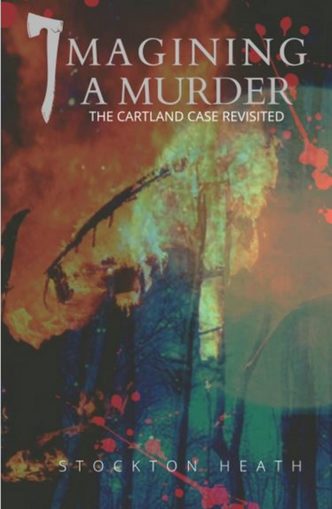
Once Upon a Moonlit Provence Night . . . author David Sedgwick reveals why he just had to write the story of a brutal, unsolved 1973 murder.
Hands up who remembers the name Jeremy Cartland? While the name is virtually unknown nowadays, such was not the case back in 1973 when it was rarely out of the news headlines. Back then “Jeremy Cartland” was as famous as Suzi Quatro, more so perhaps. Indeed, rarely a day went by in that unforgettable spring and summer of ’73 without the handsome 29-year old’s face appearing in the papers. So just how did this aspiring poet (and former English teacher) come to prominence that year?
In Spring 1973 Jeremy and his father, John had been travelling through southern France en route to Italy when the older man had been brutally murdered – ‘decapitated’ according to the tabloid press. Indeed, the manner of death had been particularly violent: the skull had been effectively crushed and whoever had dealt these vicious blows had then gone on to hack the unfortunate man’s throat with an axe in what pathologist’s described as a ‘frenzied’ attack. The autopsy revealed evidence of at least a dozen such blows, each of which could have been fatal.
Having also attacked Jeremy, the attacker(s) then set the Cartland’s Caravan alight before fleeing the scene. Who had killed the 60-year-old and for what reasons? Described by the media as a ‘Brighton headmaster’, as well as leasing out various properties, Mr Cartland ran a language school in the Sussex town. Respectable was the word. It seemed inconceivable that such a man could have enemies that would want him dead.
Part-business, part-pleasure, the trip that spring to the continent had mainly been planned in order for the Cartlands to market their summer courses to contacts in France, Italy and Switzerland. Cartland senior had also taken the opportunity to collect a Sprite Musketeer caravan he had bought from an associate living on Spain’s Costa del Sol. Towing the caravan through northern Spain and into south-east France, on the evening of Sunday, 18th March the two men decided to pull off the road at La Barben, a small village 50 Km north of Marseille.
At a place known locally as Jas de Dane, The Cartland’s Hillman Avenger duly branched off the main Route Nationale 572. The Brits had arrived at a piece of waste ground, a place well-known to local fly-tippers. They were intending to camp out before an early start the following day. Oddly, upon arrival the Cartlands turned both car and caravan around 180 degrees. Soon enough the British caravanners faced west, in the direction of Pélissanne, the town they had passed just minutes before. Why did they perform this unnecessary manoeuvre? After all, in the morning they were headed in the exact opposite direction – eastwards to the village of Jouques where, according to Jeremy, the men had decided to site their caravan on land owned by Mr Cartland.
It had been a warm day but as night fell the temperature rapidly dropped. After eating a modest meal in the caravan, the two men settled down for the night. Sometime around midnight Jeremy was aroused by noises outside the caravan. Prowlers! Rousing his father, the young poet quickly pulled on a pair of trousers over his pyjamas. Having dressed himself, he stepped out of the caravan into the chilly moonlight air . . .
No sooner had Jeremy left the caravan when he received a blow to the back of the head, hard enough to render him immediately unconscious. When he awoke, his father was missing and the caravan was a blazing inferno. Mr Cartland had been slaughtered – that much is certain. As for the rest it has always been guesswork. French police were unable to obtain a conviction. Handed over to them in summer 1973, Scotland Yard also failed to bring the perpetrator(s) to justice.
From drug couriers, the French Resistance to opportunist thieves and even Jeremy himself, there have always been plenty of theories about who carried out this cowardly and vicious attack. Certainly, Cartland’s background in wartime intelligence proved fertile ground for speculation. During the second world war the deceased man had been involved with De Gaulle’s Free France. He had also worked undercover in Sudan, Libya and Egypt. Had his murky past finally caught up with him? The dead man had always been a highly complex individual.
A brilliant scholar, shortly after graduation from Oxford university the dashing Cartland had left England for Peshawar to embark on a life of adventure. As evidenced by his remarkable linguistic ability (fluent in French, Italian, Arabic, Urdu, Pashto and a smattering of east African dialects) Cartland had certainly lived a life of adventure. In later years he could always be relied up to liven up the dinner party table with tales of his many escapades.
Perhaps his most intriguing story concerned the role he supposedly played in the liberation of Brussels. Somehow, the young intelligence officer found himself in the Belgian capital that Autumn of 1944. As German forces retreated, setting the city alight in their wake, Cartland claimed to have been the first British officer to enter Gestapo headquarters. Here he found dozens of files containing the names of French collaborators. Fearing reprisals he set fire to the files, or so he claimed. Thus, Cartland may well have made enemies due to an act which, depending on point of view, was either exceptionally brave or immensely foolhardy.
Would the Resistance, networks of which were said to be existence long after the war, really have wanted to murder him decades later? Or was it merely a case of being in the wrong place at the wrong time? Exactly What happened that moonlit Provence night and why it happened has always been unknown, until now.
A caravan ferociously burning in a strange land, as a youngster I couldn’t rid my mind of that awful image. Hardly out of nappies at the time of the murder, I must have therefore heard about the crime in the years which followed. In 1980 the BBC produced an hour-long documentary reconstructing the crime, which is when I assume I first encountered the case. To my young mind it seemed incomprehensible. Caravans I associated with family holidays, happiness and yet here was a scene of horror. Is that why it stuck in my mind? Perhaps that murder signalled the encroachment into my innocent world of a more disturbing one, a shadowy place in which adults were capable of committing acts of brutality against one another.
Whatever the explanation, this horrific crime had a profound effect on my adolescence. Often, I would go to bed and ‘see’ the caravan, somewhere in a dark forest engulfed with flames, always viewed from above as if I had been there myself. However much I might have wanted to dismiss that event, it proved stubbornly resilient. It was not until my teenage years had ended that it gradually faded away, the flames, the chaos, the darkness and most of all the thought of murder. Or so I thought.
Two years ago, I was browsing through a book about the Cote d’Azur. Mentioned in the book were a series of murders of British nationals which had occurred in the south of France in the mid-1970s. One of the cases under scrutiny was that of a man named John Basil Cartland who had been murdered camping on waste ground in 1973. Having murdered the British businessman and academic, the killer(s) had then set his caravan ablaze . . .
Decades had passed, but that revelation thrust me right back to the trepidation which had accompanied my childhood dreams. And so, at last, I finally knew the identity of that poor man who lost his life on that long ago Provence night, but at what price? While I wanted to continue with an exciting idea for a novel I had recently hatched, I kept returning back to Cartland. That awful crime had once again ensnared me. It began once more to haunt my thoughts. There was only one thing I could do.
But could I – more to the point should I – pursue this strange tale to wherever it might lead? After reading Jeremy Cartland’s 1978 account of the affair, The Cartland File my mind was made up. I set to work. Thankfully, the case attracted massive media exposure throughout 1973 so there was plenty of material upon which to draw. As well as Jeremy’s effort, a French journalist had written a contemporaneous account of this perplexing affair called L’Enigme de Pélissanne (The Pélissanne Enigma).
Twelve months of detective work, plenty of dead ends and occasional moments of serendipity has culminated in a book, Imagining A Murder: The Cartland case revisited. A truly chilling story, when I set out on this trail I could hardly have guessed to where it would eventually lead. It has been a long and arduous process. So, has it been worth it? On a personal level, I believe I have managed to finally exorcise those demons which haunted my childhood dreams. But the greatest satisfaction by far is the thought that although he has always been denied justice, with the publication of this book, John Cartland may finally be able to rest in peace.
‘Imagining A Murder: The Cartland case revisited by Stockon Heath (David’s pen name) is available on Amazon from 1st July in both paperback and ebook formats. Thereafter an ebook version will be available via Draft2Digital.com
© David Sedgwick 2021
The Goodnight Vienna Audio file
Audio Player



